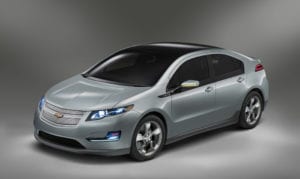Who Kissed the Electric Car?
 When GM recalled all of their leased EV1 electric cars in 2002, there was quite a bit of speculation about the conspiracy that killed the electric car. Many owners begged to keep their vehicles, but had no choice but to surrender them to GM to be crushed or put in a museum.
When GM recalled all of their leased EV1 electric cars in 2002, there was quite a bit of speculation about the conspiracy that killed the electric car. Many owners begged to keep their vehicles, but had no choice but to surrender them to GM to be crushed or put in a museum.
This fall, we’ll finally begin to see the return of electric vehicles (EVs) that have been long promised. While dreams of a Tesla Roadster or Fisker Karma may be a bit elusive, the Nissan Leaf may be just the car you’re looking for. The Leaf will be available this fall, at least for those who’ve put their names on the waiting list. The Chevy Volt, which was only available in select markets, is also expected to be available nationwide later this year and the Ford Focus has been delayed to 2012. The Top 10 electric carmakers will be battling it out to win the hearts of EV drivers.
The electric motors that drive EVs are powered by rechargeable batteries to create clean, quiet power. While traditional internal-combustion engines only convert about 20% of the energy stored in gasoline, electric motors convert 75% of the chemical energy from the batteries to power the car. Given the fact that tailpipe emissions account for 27 percent of the greenhouse gases, many people are looking to electric vehicles to reduce our overall carbon emissions. While EVs have no emissions, the power plant that originally produced the electricity may if it used coal or natural gas as its fuel source. So many environmentally-conscious EV owners opt for charging their vehicles with solar.
Is an EV right for you? It depends on your driving needs. The range on the Leaf and Focus is about 100 miles. Most people don’t drive more than 20-30 miles to work every day, so a round-trip would typically be less than 60% of the battery capacity. The vehicles can be charged using standard 110 volt household circuits, though that takes up to 16 hours to fully charge the batteries. All new cars come with a standard charge adapter that can also do a faster 240 volt charge in less than half the time. The batteries can be charged more quickly when they are low, but as they reach the full charge, it takes longer for the energy transfer to take place.
EV charging stations are just now beginning to pop up in public places. They are still fairly rare, as most businesses are waiting for the demand to be there before they invest in charging stations. Some employers, like Novus International, are installing charging stations to encourage their employees to purchase electric vehicles. The Moonrise Hotel installed a charging station in a prime spot in front of the hotel to provide hotel guests with a place to charge their electric car. Soon, cafés and coffee shops will install charging stations in near their front doors to attract customers.
Coulomb Technologies is a premiere manufacturer of EV charging stations. Their ChargePoint Network enables EV owners to find charging stations using smart phones, and users are sent text messages when charging is complete or interrupted. While many retailers will offer the electricity for free (a full charge typically only costs $1-$2.00), the charging stations can be programmed to charge enough for the stations to be a modest money-maker. Not at all unlike our current gas stations.
So if you have a predictable commute and are committed to energy efficiency and green lifestyle, you’ll probably love having an electric car. Maybe enough to give it a big kiss!
P.S. For fun, you might check out The EV-Hater’s Guide to Hating Electric Cars.
This was published in the Going Green section of the September 2011 issue of Spirit Seeker magazine.
